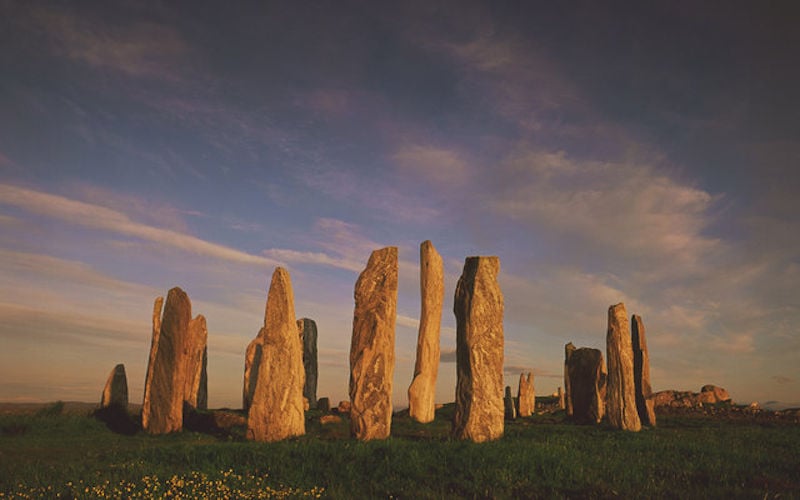
Podcast: History Fuzz: Episode 04: Dr. Kenneth Brophy. Scotland Pt 1. Neolithic astronomy and Glasgow's lost alignments
In this engaging episode, we delve into the world of Neolithic and early Bronze Age Scotland through the insights of Dr. Kenneth Brophy, a distinguished senior lecturer in the Department of Archaeology at the University of Glasgow.[1] With a remarkable 25 years of experience excavating and interpreting Scotland's monumental landscapes, Dr. Brophy has become a leading authority on the region’s ancient history. Our conversation takes us through lunar alignments, and the ritualistic functions of Neolithic monuments, but also into his innovative approach to longstanding archaeological debates, particularly focusing on the controversial “leyline” maps of Harry Bell.
Dr. Brophy and I first crossed paths in 2002, when he was a burgeoning archaeology student meticulously excavating standing stones in Caithness, a region on Scotland's northeast coast. At the time, I was engaged in field walking, searching for flint arrowheads alongside one of his colleagues. Our shared passion for uncovering the secrets of Scotland’s ancient past set the stage for our deepening exploration of the country’s enigmatic landscapes.

Figure 01. The Grey Cairns of Camster, two ancient Neolithic chambered cairns in Caithness, Scotland, feature complex architecture with central burial chambers accessed via narrow passages. (David Shand / CC BY-SA 2.0)
In this episode, Dr. Brophy sheds light on his fresh academic perspective regarding the 1970s maps created by Harry Bell, a Glaswegian lay-hunter who proposed a network of geodetic alignments connecting prehistoric sites across Glasgow and central Scotland. Inspired by Alfred Watkins' concept of ley lines, Bell’s idea has sparked considerable debate within the archaeological community. Dr. Brophy’s approach critically reassesses Bell’s maps, offering new interpretations based on recent research and fieldwork. Additionally, having reviewed the Bell archives myself, I present Dr. Brophy with new alignments that further challenge existing notions about the spatial relationships between ancient sites, suggesting alternative explanations for their alignment and significance.[2]
In a compelling exchange of ideas, Dr. Brophy reveals a remarkable phenomenon: every 18.6 years, during the lunar minima, the moon aligns with the landscape to produce a breathtaking cosmo-mythological event. This alignment vividly illustrates how ancient peoples may have woven celestial cycles into their cultural and ritual practices. Dr. Brophy’s research underscores the deep connection between the natural world and the ceremonial life of Scotland’s prehistoric inhabitants, suggesting that such lunar events likely played a significant role in shaping their myths and rituals. As we delve into these celestial connections, I present Dr. Brophy with a new lunar observation, further enhancing our understanding of how these astronomical phenomena may have influenced cultural and ritualistic traditions in Neolithic northern Scotland.

Figure 02. The Callanish Stones are a cruciform arrangement of Neolithic standing stones centred around a stone circle, located on the Isle of Lewis, Scotland. (Tom Richardson / CC BY-SA 2.0)
Dr. Brophy’s expertise also extends to the long straight cursus monuments that are prevalent in Scotland’s Neolithic landscape. These monuments, often leading to standing stone settings, have long puzzled archaeologists and historians. Drawing on his findings from the western Isle of Arran, Dr. Brophy offers new interpretations of their ritualistic functionality. He proposes that these cursus monuments were not merely architectural features but integral components of ceremonial landscapes. Their alignment and placement suggest they played a significant role in guiding and organizing ritual activities, reflecting the complexity and significance of ceremonial life during the Neolithic period.[3]
Additionally, Dr. Brophy examines how certain architectural features and burial practices reflect the cultural attitudes towards death and the afterlife in ancient Scotland. His insights into these practices provide a deeper understanding of how early societies perceived and ritualized death, shedding light on their beliefs and customs. Another compelling topic in our conversation is Dr. Brophy’s exploration of Scotland’s geometrical carved stone balls. These enigmatic artifacts, found across various Neolithic sites, have intrigued researchers with their intricate designs and uncertain purpose. Dr. Brophy's analysis suggests deep religious meaning behind these carvings and a central role within Neolithic society. However, I argue for a more utilitarian reason, proposing that these artifacts may have primarily served practical functions within their communities, reflecting everyday needs rather than solely religious or ceremonial purposes.




